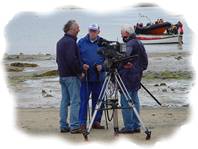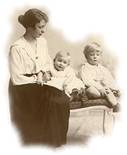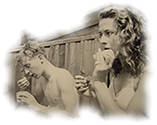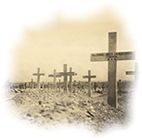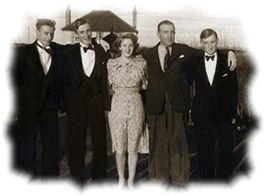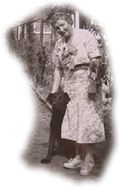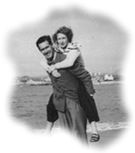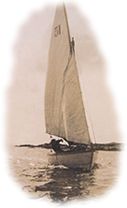A unique 16mm Film Diary Archive - circa 1920s - 60s. The Alexander Archive is a unique and fascinating 16mm film diary recording for over 44 years the lives of an upper class family throughout the twentieth century. It consists of 13,000 feet of previously unpublished 16mm cine film - carefully preserved - the film reels are still in their original dated Kodak boxes, accompanied would you believe by the original projector and case, still in fully working order.
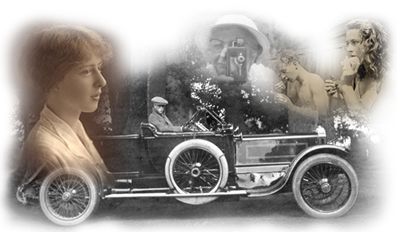




ACQUISITION
OF THE ARCHIVE
Miss
Alexander died in 1983 - her camera, projector and films were discovered in
the attic of her house in the Wirral. The clearing of the house was left to
her nephew, Gemmell Alexander, who as he terms it "binned the film, projector
and camera" and sentenced it to the auction rooms. The camera, which was by
now "knackered" due to the extensive amount of celluloid that past
through its gate, was sold off separately. A Chester man bought the projector
and film footage for his son Tom Barham , all stuffed together in dusty old cardboard
boxes. Like most relics the journey of the old films was destined for yet another dark attic in Ruthin
and thanks to tom it was preserved for yet another 13 dusty years before seeing the light of day.
Then in August 1996 Tom, advertised the old films to go to either one good home or many.
As he joked "it could end up in a car boot sale for 50p a can at the weekend"
- and it was Thursday! Valleystream quickly rescued the squealing cans of
film and projector. It was some time later before any work began on the long
and arduous task to research its origin. Having to start, of all places, on
the other side of the world in New Zealand before chasing down Gemmell, who was only 100
mile away in Cumbria !
Researchers
at ValleyStream Studios discovered the unusual name 'Towle' written on a 1952
film reel shot in Auckland, New Zealand - the time frame being 50 years on.
They rang up international directory enquiries and were surprised to find
a living Towle still over there. The first person ValleyStream spoke to on
the telephone turned out to be the cousin of Simon Towle, now a scientist
with the World Wildlife Fund in New Zealand, who appeared in the film footage
as a toddler. Simon's mother Hilary had been brought up by her aunt Miss Alexander!
- the camerawoman. Then there was a phone call at 3am in the morning UK time
from Simon himself, who was totally stunned with emotion to hear about the
discovery of the 16mm motion picture archive, containing most of his relatives
and his mother, who had recently died.
Simon
Towle put Stef Bate the producer in touch with his uncle Gemmell, who appears in
the films as a child and who was equally astonished to find the dusty old
footage had turned up 13 years later (Gemmell admits to being the culprit
who job-lotted it away when his Aunt died). Now living in Cumbria, Gemmell
is in his eighties and has been enjoying working on the Archive with ValleyStream
ever since.
The
Alexanders Chronicles/still/motion picture images are strictly copyright to
ValleyStream 2002



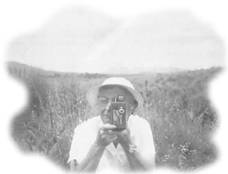
The
camerawoman was Miss Alexander - Miss "A" for short - a wealthy young
girl, who used the latest technology of her day: a Cine-Kodak B B Junior 16mm
clockwork camera,each wind gave only 29 seconds of shoot time, and she never
used a tripod - being wooden (probably made of ash) they would have been too
heavy for her - instead she often used the nearest available fence post. She
filmed extensively from the 1920s to 60s, first using black and white film,
then using colour from 1937; her footage shows the development of Kodak film
stock. Miss A's movie footage records many aspects of the twentieth century
in Wales, England, and abroad, even filming specific world events, such as:
Hitler and the Nazis at Nuremberg in 1934; George V's Silver Jubilee celebrations
in 1935; young Queen Elizabeth's visit to New Zealand in 1953; and the film
set in Wales for Ingrid Bergman's 1958 movie The Inn of the Sixth Happiness.
Film experts throughout the UK are now classing the film archive as a rare find
and a national treasure, and the British Film Institute along with a number
of other respected organisations are very eager to acquire the whole collection.
ValleyStream
Media Developments, an AV/Film production company based in the Conwy Valley,
North Wales, and
producers of special interest media, have been carefully restoring, researching
and developing the Alexander Archive over the last 6 years. Finally launched
in spring 2002, the discovery of the collection featured throughout the national
press and on the Richard and Judy show, etc. A hi-tech cleaning and restoration
unit was devised to clean and repair the film at the Studios, nick named the
'Raspberry Blower' because of the noise it made as the film passed through
it. Producer Stef Bate, production assistants Ange Davies and Jan Foulkes spent
8 weeks working with the unit on the difficult task of restoring the film.
Accompanying the film archive there is also a small collection of period photographs
which have been beautifully restored using digital technology by imaging assistants
Janie Chaloner and Vikki Lane.
Miss
A with her trusty Kodak BB Junior 16mm cine camera in her 70s - still shooting
film!
ValleyStream
and the BBC have just finished producing four TV documentaries based on the
Alexander Archive. The mini series was shown on BBC1 North September
2002 -
featuring on the " Inside Out" programme for three weeks. A 30-minute special
documentary was screened nationally on the BBC
2 July 2002.
Gemmell
revisits Trearddur Bay for the documentary cameras
THE
FAMILY 1920s - 30s
Miss
Alexander was born in 1893 into an affluent Liverpool family; her father and
brother were partners in an accountancy firm, Harmwood Banner, which is now
established worldwide.
Her sister-in-law,
Winifred, had been a close friend of the Prince of Wales (future Edward VIII)
in about 1914 during his studies at Oxford. They picnicked and went partying
together, with Edward coming to pick her up in his Bentley.
The young
Prince gave Winifred a signed photograph of himself. This shows the affection
he had for Winifred. Why they never continued their close bond is unsure,
but could Winifred have been the Prince's first love?
Young
Winifred
Young
Prince Edward in his Bentley
Miss
Alexander reading a book
Prince
Edward went off to war in 1914, and "Winnie" returned to the Wirral
as a nurse where she married a childhood admirer - a wounded soldier called
Harold Alexander. They had 4 children then tragedy struck a cruel blow - Winifred
died suddenly in 1930, her bereaved husband and three sons (Gemmell, Stuart
and Donald) and daughter (Hilary) came to live with Miss Alexander in the Wirral.
This new family unit already had several domestic servants, including a cook,
cleaner and chauffeur. One of the house workers, Miss Hopley, became Miss Alexander's
housekeeper and companion, eventually staying with her for over 40 years. With
the children being a handful, Miss A also took on three governesses (Olga and
Erica from Switzerland, and Anne-Marie from France).
Where-ever
Miss Alexander went, her camera was always in her hand. The boys eventually
went to Sedbergh School in Cumbria, where she filmed them running during the
annual 3- and 10-mile races at Sedbergh which are still run today. She shot
also traditional scenes around the Wirral and in North Wales such as sheep-shearing
by hand and horse-drawn ploughing; the Mersey Ferry and Liverpool docks; military
parades at Sefton Park during George V's Silver Jubilee in 1935; HMS Conway
(a Royal Navy training ship which floundered in the Menai Strait); barges
being towed down river; and a 1930s film set in Richmond. The family also
travelled abroad, and the cine camera went along too. In 1934 they travelled
down the Rhine to Germany where she just happened to film Hitler and parading
Nazis during a rally in Nuremberg from an upstairs window. Equally strange
and still under investigation, she filmed German aircraft on airfields - not
really your usual tourist scenes. Was there more behind all this? Back to
reality, she recorded scenes of horse-drawn carts on Sark and fishermen loading
nets onto a handcart in Majorca. In 1938 she toured France, filming everything
in sight!
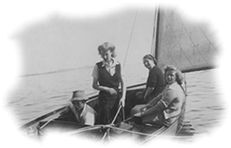
The
Alexanders loved their pleasure and owned an idyllic holiday home at Trearddur
Bay on Anglesey where Miss Alexander carried on her second passion, sailing
her half rater boat. The Bay was a holiday hotspot for many wealthy Liverpool
families, including Nicholas Montsarrat who wrote 'The Cruel Sea' in 1951. Along
with the Alexanders he was a member of the Trearddur Bay Sailing Club. Their
main boat was named 'Dot' after a close friend of Miss Alexander (Dorothy Dowding).
WORLD
WAR II
Then
war broke out - and Anne-Marie who was now probably part of the French resistance
saved the life of Gemmell when he was serving in the 51st Highland Division.
He failed to make it to Dunkirk and was stuck five miles behind enemy lines
near Rouen. He had to shoot a German soldier who tackled him and escaped to
Nantes where Anne-Marie was living with her mother and child. She hid him
in her attic for two months despite the considerable risk to herself, her
family and neighbours, who could well have all been shot if the Nazis had
found her hiding a British officer.
Gemmell
was eventually smuggled onto a Polish trawler - bombs exploding by its side
from German Stuker dive-bombers - and managed to escape to England. He bumped
into his father in a country lane, who announced they all thought he was dead!
Gemmell went on to become a major and led the British troops in liberating
Italy.
Winifred
Alexander with her children - sadly, she died aged 30
Miss
'A', Hilary and Donald sailing 'Dot' on the Welsh coast!
Gemmell
and Anne Marie licking ice creams - she saved his life from the Nazis in France
The
second nephew, Stuart, was in the Cheshire Yeomanry. During the War he wrote
to his sister, Hilary, as he moved around between army bases in England, Ireland
and the Middle East. In his 30 or so letters, which are now part of the archive
with ValleyStream, he longs for the peaceful enjoyment of his childhood at Trearddur.
He was against the war until he realised that if the Nazis invaded Britain his
family could be shot murdered and raped - sadly, Stuart never saw his beloved
Anglesey, Coppermine Creek or his family again - he was killed at the Battle
of Alamaine in 1942 (aged 22) after stepping backwards onto a land mine whilst
guiding a truck through a minefield.
Gemmell was also fighting in the battle as one of Monty's majors but he didn't
know his brother was only a mile away at the time; he was called over to bury
his brother and collect his possessions.
This
was to be a landmark tragedy within the Alexander Clan, and was the end of an
era when as four kids they played so innocently at Coppermine Creek - the dreaded
reality of the war Stuart so poetically feared had finally struck an evil blow
to the flow of his ink and his unfulfilled life! A shear waste, like many robbed
by, ironically, the very man his Aunt, Miss Alexander, had filmed only a few
years earlier in Nurumberg, Germany - Hitler!
The
niece, Hilary, joined the Wrens and undertook special duties. In fact she was
a code breaker at Bletchley Park during this time, and received 3 war medals
in 1989. After the 50 year silence she was informed that she could now talk
about her war work - but she never did. Not even her husband John ever knew
what her actual role was - and she died 2 years later. Hilary was buried with
the Union Jack and her silence went with her. The role of these Wrens or "chicks"
was kept very low key so as not to attract the attention of possible enemy agents
in the UK. Many of the girls were in fear of there lives, scared to such an
extent that they never discussed, even with each other , their particular role
within the Bletchley Park walls. Even after the war had ended they still felt
threatened and hid so well their secret activities for much of their lives!
Catherine Caughey, one of the Wrens, said Hilary must have been a top notch
code breaker to have been released so late in 1946. Catherine has written a
book called ' World Wanderer' on her own life , including the times she spent
working at Bletchley Park.
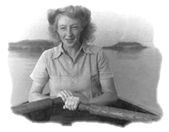
One of Miss A's very close friends was Dorothy Dowding, who also lived with
her at one point. It now seems that her husband, Commodore Dowding (Royal Navy),
was a key member of Churchill's War Cabinet and recommended Hilary for her work
at Bletchley Park - as more stones are unturned the war effort connections with
the Alexanders deepens! It all adds to an already amazing story!
AFTER
THE WAR
Miss
Alexander travelled extensively throughout her life, always shooting the occasions
on camera. She visited Curacao, Panama and Cape Town, then in the 50s and
60s she made several sea-journeys on luxury liners like the Classic "SS
Oriana" (now a floating theme park and museum in the Chinese port of
Dalian) and the "SS Camberra.On these ships she sailed to visit her niece,
Hilary, who went to live in New Zealand, and she toured throughout New Zealand
and Australia. Although Miss Alexander recorded street life and landscapes,
she had an eye for ships, cars and machinery, etc , so her footage shows such
items as the rack and pinion engines of the Panama Canal, mining steam dredgers,
and Bentleys being winched aboard ship.
In the
Wirral Miss Alexander was a noted personality. In 1946 she became the first
woman councillor for the Heswall/Oldfield area and the first woman chairperson
of Wirral Urban District Council. She had a local community hall built for
elderly people which was named after her (the Alexander Hall), and she was
an active member of the Soroptimists. In 1983, after several years in a nursing
home, Miss Alexander died, aged 89, which brought to an end her amazing love
affair with a Kodak motion picture camera.
Hilary,
her niece, travelled to New Zealand in 1951where she met and married John Towle.
He was a representative on the Bicultural Commission for the Anglican Church,
and was involved in resolving historical grievances between the Maori People
and Non Maori over land. Hilary continued to sail, going to sea with Sir Peter
Blake in 'Lion New Zealand' (a yacht which he sailed in the Whitbread Round
the World Yacht Race). She died in 1989. Her daughter, Susan, and son, Simon,
still live in New Zealand today. Sadly Sir Peter Blake was shot dead in 2002
on his yacht by pirates while sailing down the amazon a tragic end.
The
youngest nephew, Donald was a gifted sailor, eventually becaming a doctor. He
moved to Suffolk, where Miss Alexander filmed his growing family - Anne-Marie's
daughter (Marie-Francoise) came over from France to look after his children.
Donald died in the 1990s.
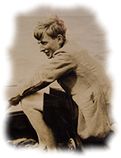
Gemmell,
her eldest nephew, became an explorer and collecting specimens for the British
Museum. He is the only surviving military MBE left in the UK, and rose to the
rank of major during WW2 whilst a right hand man to General Montgomery. Both
during and after the war Gemmell came into contact with many influential people.
He entered Colonial Service in 1946 and lived abroad for many years. Now in
his eighties, Gemmell is the only remaining survivor of the original Alexander
children from the film footage and is still active today. He has also been involved
in recent filming for the joint ValleyStream/BBC television documentaries. During
filming in August 2002 on Anglesey, Gemmell was reunited with the children's
old boat, 'Dot', which he had last seen over 60 years ago. 'Dot'
is still based at Trearddur and going strong; in fact, she even wins sailing
races for her present owner - Gemmell says he was always more interested in
fishing for lobsters!
Stuart
Alexander, reading. He made the ultimate sacrifice at the Battle of Alamein
Stuart
Alexander's grave at Alamein 1942
Hilary
flexing her muscles in a rowing boat
Miss
'A' at home in the Wirral
Hilary
escaped to New Zealand away from a broken romance.
The
boat, 'Dot', is still winning races at Trearddur today
"The
last reunion" of the Alexanders in1939 - Stuart (right) was killed in
battle a few short years after this picture was taken




